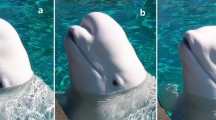Abstract
Seven groups of socially living baboons between the ages of 0 and three months were observed at the Southwest Foundation for Research and Education, San Antonio, Texas. Six groups were harems containing one adult male (the biological father), the nursing mothers and their infants, and adult females without offspring. The other group consisted only of nursing mothers and their infants. All seven groups were housed in identical outdoor enclosures 45 m × 27 m × 23 m.
Fourteen behavioral categories were tested. The hypothesis that behavioral sex differences in infant baboons are influenced by the presence of an adult male was not supported by the test results. Sex differences were not detected in either the mother-reared infants or in harem-reared infants. Mother-reared infants (n=13) had significantly greater scores for contact aggression and non-contact aggression categories, whereas harem-reared infants (n=12) scored significantly higher for locomotion, non-aggressive social behaviors, exploration, and rough-and-tumble play.
Similar content being viewed by others
References
Alpert, S. &L. A. Rosenblum, 1974. The influence of gender and rearing conditions on attachment and response to strangers.Proceed. 5th. Int. Congr. Primatol.,S. Kondo,M. Kawai,A. Ehara, &S. Kawamura (eds.), S. Karger, Basel, pp. 217–231.
Bramblett, C. A., 1976.Patterns of Primate Behavior. Mayfield Pub. Co., Palo Alto, California.
DeVore, I., 1963. Mother-infant relations in free-ranging baboons. In:Maternal Behavior in Mammals,H. L. Rheingold (ed.), J. Wiley & Sons, New York, pp. 305–335.
Dolhinow, P. J. &N. Bishop, 1970. The development of motor skills and social relationships among primates through play.Minn. Symp. Child Psychol., 4: 141–198.
Harlow, H. F. &M. K. Harlow, 1962a. The effect of rearing conditions on behavior.Bull. Menninger Clin., 26: 213–224.
———— & ————, 1962b. Social deprivation in monkeys.Sci. Am., 207(5): 136–146.
————XXX& H. E. Lauersdorf, 1974. Sex differences in passion and play.Perspect. Biol. Med., 17(3): 348–360.
Hinde, R. A. &L. E. White, 1974. Dynamics of a relationship: rhesus mother-infant ventroventral contact.J. Comp. Physiol. Psychol., 86: 8–23.
————,XXX& Y. Spencer-Booth, 1964. Behaviour of socially living rhesus monkeys in their first six months.Proceed. Zool. Soc. London, 143: 609–649.
Jay, P., 1963. Mother-infant relations in langurs. In:Maternal Behavior in Mammals,H. L. Rheingold (ed.), J. Wiley & Sons, New York, pp. 282–304.
Jensen, G. D., R. A. Bobbitt, & B. N. Gordon, 1966. Sex differences in social interaction between infant monkeys and their mothers. In:Recent Advances in Biological Psychiatry, Vol. 9,J. Wortis (ed.), pp. 283–293.
————, ————, & ————, 1968. Sex differences in the development of independence of infant monkeys.Behaviour, 30: 1–14.
Kummer, H., 1968. Social organization of hamadryas baboons.Bibl. Primatol., 6: 1–189.
Mitchell, G. D., 1968. Attachment differences in male and female infant monkeys.Child Dev., 39: 611–620.
————, 1970. Behavioral differences related to experience of the mother and sex of the infant in the rhesus monkey.Dev. Psychol., 3: 149–159.
Ransom, T. W. &T. E. Rowell, 1972. Early social development of feral baboons. In:Primate Socialization,F. Poirier (ed.), Random House, New York, pp. 105–144.
Redican, W. K., 1976. Adult male-infant interactions in nonhuman primates. In:The Role of the Father in Child Development,M. E. Lamb (ed.), John Wiley & Sons, New York, pp. 345–385.
Rowell, T. E., N. A. Din, &A. Omar, 1968. The social development of baboons in their first three months.J. Zool., 155: 461–483.
Simonds, P. E., 1974. Sex differences in bonnet macaque networks and social structure.Arch. Sex. Behav., 3(2): 161–166.
Young, G. H. &C. A. Bramblett, 1977. Gender and environment as determinants of behavior in infant common baboons (Papio cynocephalus).Arch. Sex. Behav., 6(5): 365–385.
Author information
Authors and Affiliations
About this article
Cite this article
Young, G.H., Hankins, R.J. Infant behaviors in mother-reared and harem-reared baboons (Papio cynocephalus). Primates 20, 87–93 (1979). https://doi.org/10.1007/BF02373830
Received:
Accepted:
Issue Date:
DOI: https://doi.org/10.1007/BF02373830




